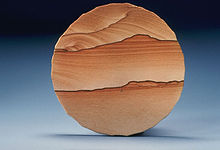Berea sandstone
| Sedimentary rock | |

Cut slab of sandstone showing Liesegang banding
|
|
| Composition | |
|---|---|
| Typically quartz and feldspar; lithic fragments are also common. Other minerals may be found in particularly mature sandstone. |
Sandstone is a clastic sedimentary rock composed mainly of sand-sized (0.0625 to 2 mm) mineral particles or rock fragments.
Most sandstone is composed of quartz or feldspar because they are the most resistant minerals to weathering processes at the Earth's surface, as seen in Bowen's reaction series. Like uncemented sand, sandstone may be any color due to impurities within the minerals, but the most common colors are tan, brown, yellow, red, grey, pink, white, and black. Since sandstone beds often form highly visible cliffs and other topographic features, certain colors of sandstone have been strongly identified with certain regions.
Rock formations that are primarily composed of sandstone usually allow the percolation of water and other fluids and are porous enough to store large quantities, making them valuable aquifers and petroleum reservoirs. Fine-grained aquifers, such as sandstones, are better able to filter out pollutants from the surface than are rocks with cracks and crevices, such as limestone or other rocks fractured by seismic activity.
Quartz-bearing sandstone can be converted into quartzite through metamorphism, usually related to tectonic compression within orogenic belts.
Sandstones are clastic in origin (as opposed to either organic, like chalk and coal, or chemical, like gypsum and jasper). They are formed from cemented grains that may either be fragments of a pre-existing rock or be mono-minerallic crystals. The cements binding these grains together are typically calcite, clays, and silica. Grain sizes in sands are defined (in geology) within the range of 0.0625 mm to 2 mm (0.002–0.079 inches). Clays and sediments with smaller grain sizes not visible with the naked eye, including siltstones and shales, are typically called argillaceous sediments; rocks with larger grain sizes, including breccias and conglomerates, are termed rudaceous sediments.
...
Wikipedia
